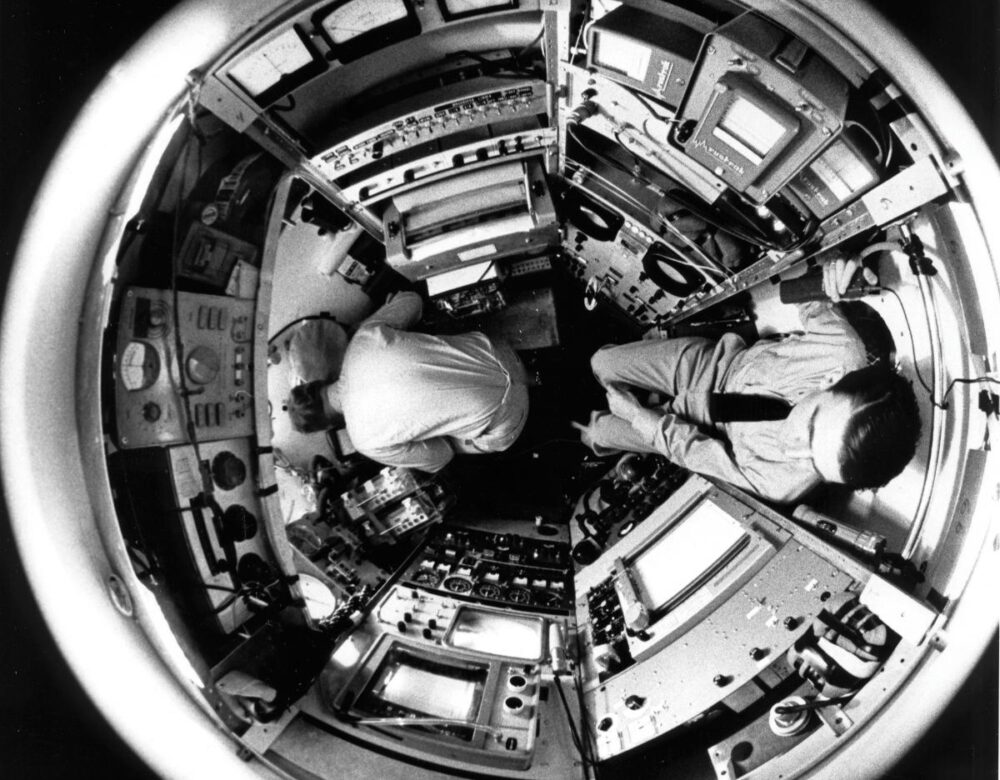The Challenger Deep in the Pacific Ocean is the deepest point on the earth’s surface. Scientists have always wanted to see if there’s life down there but didn’t dare make the deep-underwater descent. That is, until 1960 when a Navy Lieutenant and a Swiss engineer took the first deepest dive.
About The Disappearing Spoon
The Science History Institute has teamed up with New York Times best-selling author Sam Kean to bring a second history of science podcast to our listeners. The Disappearing Spoon tells little-known stories from our scientific past—from the shocking way the smallpox vaccine was transported around the world to why we don’t have a birth control pill for men. These topsy-turvy science tales, some of which have never made it into history books, are surprisingly powerful and insightful.
Credits
Host: Sam Kean
Senior Producer: Mariel Carr
Producer: Rigoberto Hernandez
Audio Engineer: Jonathan Pfeffer
Transcript
The submersible had already sprung two leaks. And communication with the surface had already been cut off. But not until 32,000 feet deep did the two submersible pilots truly feel terror.
A thunderclap noise sounded, and the submersible bucked and shuddered. Pilots Jacques Piccard and Don Walsh slammed into each other in the tiny cockpit.
Scarily, their Plexiglass window—despite being 15 inches thick—had cracked. The intense water pressure around them crushed it. Piccard and Walsh froze. They braced for the submersible to split in half, to implode, for cold water to rush in—and implode them.
But the window somehow held. And when the duo checked their instruments, everything else seemed fine. So they talked things over. Should they retreat to the surface? Or keep descending to their goal—the mysterious Challenger Deep, the deepest point on Earth’s surface?
The reasons to retreat were obvious. The pressure would only increase as they dropped. Who knew how long the Plexiglass would hold?
Then again, they were so close to the bottom. And if something catastrophic was going to happen, well, they were too deep to get help anyway. Piccard and Walsh agreed. They would continue on—continue down. The only real question was what, if anything, they would find down there.
Jacques Piccard was the son of the famous balloon pioneer Auguste Piccard from the last episode. In fact, Auguste designed the world’s first deep-sea submersibles in the 1940s by adapting his knowledge of balloons for underwater vehicles. Piccard actually called his submersibles “underwater balloons.”
Similar to balloons, Piccard knew that the key to designing submersibles was controlling their buoyancy—their up-and-down motion in the water.
Now, getting a submersible to descend was easy. Carry a bunch of iron ballast onboard, and you sink right down.
Rising took more work. In balloons, you rise by using a bag of a gas that’s less dense than air. With submersibles, Piccard used a container of a liquid that’s less dense than water. He chose gasoline.
To be clear, the submersible wasn’t burning gasoline for fuel like a car. Gasoline is simply lighter than water. That’s why gasoline sits on top of puddles and gives them a rainbow sheen.
Piccard’s submersibles would carry both iron ballast and a tank of gasoline. When the vessel reached its target depth, it would dump the iron ballast, and the buoyancy of the gasoline tank would lift it back to the surface.
But if balloons and submersibles were analogous in some ways, submersibles were still a far more daunting challenge. To protect a balloon pilot from high altitudes, Piccard used only a thin metal shell. But the water pressure in ocean trenches can reach 16,000 pounds per square inch.
That’s enough pressure to crush your lungs into a marble. Clearly, a thin metal shell would fail. So Piccard consulted with craftsmen in Europe who designed beer kegs. These kegmeisters helped design a thick sphere for the submersible cockpit.
Piccard’s first dive took place in 1948 off western Africa. Unfortunately, the submersible suffered damage in a storm during deployment. So Auguste decided to redesign it, with the help of his son Jacques.
Jacques was a former teacher and soldier in his early twenties. While his father was lovably goofy-looking, with messy hair and glasses, Jacques was handsome and fashionable, with a devastating smile.
The submersible redesign took five years. The result was a legendary vessel called the Trieste. It looked something like a mutant fish.
On top was the fish’s body, a fifty-foot-long tank holding 10,000 gallons of gasoline. It was painted white with black zebra stripes. Its steel walls were five inches thick.
The cockpit for the Trieste was a sphere bolted below the gas tank. It had a single observation window—which gave it the look of a creepy dangling eyeball.
The eyeball cockpit had just 38 square inches of space inside, barely enough for two people—especially gangly tall people like the Piccards.
Auguste and Jacques debuted the Trieste in 1953. They dove two miles deep off the coast of Italy—a new world record. This made Auguste the only person in history to set both an altitude record and a deep-sea depth record.
But his son Jacques was more ambitious still. He set his sights on the ultimate record in submersible diving—reaching the lowest point on Earth, the Challenger Deep in the Pacific Ocean.
Challenger Deep is part of the Mariana Trench 200 miles southwest of Guam. It’s 35,800 feet down, nearly seven miles. If you dropped Mt. Everest into Challenger Deep, there still would be 7,000 feet of water above it. And Jacques Piccard was determined to be the first human being to visit that depth.
And perhaps the first lifeform ever. You see, there was a heated scientific debate then about the limits of life on Earth. Many biologists flat-out declared that no life could exist in Challenger Deep, for several reasons.
First, the temperature was barely above freezing. There was also no sunlight down there. That ruled out the presence of plants, which require sunlight to photosynthesize food. Having no plants also seemed to rule out animals, since plants are the basis of the food chain.
Plus, there’s the pressure. How could any creature survive 16,000 pounds per square inch?
Given that Challenger Deep seemed likely to be barren, several governments around the world were discussing a possible use for the place—as a radioactive garbage dump. In the 1950s, governments were building atomic weapons and atomic power plants. Both produced radioactive waste as a byproduct. This waste takes centuries, even millennia to break down. So where should we store such waste? How about Challenger Deep? It was barren anyway, right?
But the Piccards weren’t so sure. Yes, they understood the arguments for why life was supposedly impossible down there. But that’s not how science works—assumptions don’t cut it. To see whether Challenger Deep truly was barren, someone would have to go down and take a look.
To reach Challenger Deep, the Trieste submersible would need to be even thicker and stronger than before. So the Piccards partnered with the U.S. Navy for funding. After two years of refurbishment, the vessel was ready by 1960.
By this point, the 76-year-old Auguste was too brittle to dive under such demanding conditions. He remained involved in the project as a consultant. But he turned his seat in the eyeball cockpit over to Don Walsh, an oceanographer with the U.S. Navy. Jacques would pilot the Trieste, with Walsh as his lieutenant.
The Trieste and its support ship arrived in the Pacific Ocean over the Challenger Deep in January 1960. Or at least in the neighborhood. In the days before GPS, the exact location of Challenger Deep below the water was vague.
To find the exact location, the Piccards probed the depths with a technique called echo-sounding. Which sounds sophisticated. But really, it involved trawling back and forth in the ship and dropping waterproof dynamite overboard.
When the dynamite exploded—<BANG>—it created sound waves that echoed off the bottom of the ocean and returned to the surface. The Piccards listened for the returning waves with an underwater microphone. The longer the delay, the deeper the ocean was at that point. The longest delay—14 seconds—equaled Challenger Deep.
The record-setting dive was scheduled for January 23, 1960. Secretly, before it started, a crew member secured a Rolex watch to the outside of the submersible. The company wanted to test its latest high-tech timepiece in the most challenging environment possible. Doing this was actually illegal, since Rolex was a company, and the Navy forbade all commercial enterprises on its missions. But the crew was too curious about the watch not to try.
Unfortunately, the weather was rough that day, with 25-foot swells. Soon, the U.S. Navy command center in San Diego sent word to cancel the dive.
But on the support ship, the officer who received the message just ignored it. This was a risky move. He likely faced a court martial if things went wrong. But he thought too much was at stake to stop.
Jacques Piccard and Don Walsh slithered down into the eyeball cockpit. And at 8am, the underwater balloon finally began its descent toward the lowest point on Earth. Or what might be called, from another perspective, the nearest point to hell.
Inside the descending submersible, things got dark quickly. After about 250 yards, sunlight simply cannot penetrate water anymore.
The temperature plummeted in tandem, to 45 degrees. Piccard and Walsh changed into heavy sweaters—although that wasn’t easy, given that they were practically sitting in each other’s laps. For food, they had only chocolate bars, which they munched while their teeth chattered.
At first, the trip was boring. They were dropping at one yard per second—really slow. All they could see through their observation window was a stream of tiny glowing sea critters who were bioluminescent. It looked pretty, like upside-side snow.
But the amusement quickly wore off. After which, it was back to boredom. At least, until things started going wrong.
A small leak opened at 10,000 feet. Water was seeping in through some electrical wiring. A second leak opened at 18,000 feet. These were eerily reminiscent of the leaks that Auguste Piccard had battled during his balloon flights.
But if Jacques wanted advice from his father, he soon lost his chance to ask. The Trieste contained a sonar telephone to communicate with the support ship above. But at 18,000 feet, the telephone failed. For years, Auguste had been mentoring Jacques through every step of piloting a submersible. Now, the father couldn’t help. The son would have to complete this mission alone.
Unfortunately, things got worse from there. The submersible’s depth gauge malfunctioned—the so-called fathometer. Without a working fathometer they were essentially flying blind.
Even worse, at 32,000 feet… <CRACK> …the Plexiglass window cracked. It was a terrible scare. But Jacques and Walsh kept descending. They were determined to reach the bottom.
But how far was that? The depth gauge sat there uselessly. They didn’t want to slam into the ocean floor and damage anything, especially not with a cracked window. After an empty half-hour of sinking, Piccard asked, “Do you think we missed the bottom?” The joke lightened the mood, but the nervousness persisted.
Miraculously, the fathometer somehow woke up at 35,500 feet—just 300 feet above the floor. Hurriedly, the pilots snapped on the exterior floodlights and stared through the window.
At this point, Jacques saw a fish—a flat one, like a halibut or sole. Now, for reasons I’ll circle back to, many people today doubt Jacques actually saw a fish.
But if he did, it was about the last thing he saw. At eight feet to go, the pilots finally glimpsed the bottom—a thick layer of ivory-colored muck. A few seconds later they plopped down—and kicked up a huge cloud of silt.
The duo tried to keep looking through the cracked window, straining to see whatever they could. But it was like looking into a bowl of milk.
Unable to see anything, they took a selfie. Walsh held up an American flag, Jacques a Swiss one. And unlike, say, Neil Armstrong, they uttered no historic words about mankind. Just being there was enough—35,797 feet down.
Given the milky water and the cracked window, Jacques and Walsh decided to head up after just twenty minutes on the bottom. They dumped two tons of iron ballast. Then the buoyant gasoline took over, and they began rising.
The trip up took three dull, but thankfully uneventful, hours. First thing at the surface, Jacques and Walsh checked on the watch. It was still ticking. Rolex made a hell of a timepiece.
As they bobbed on the waves, waiting to be picked up, Jacques and Walsh speculated about how many years would pass before the next person returned to Challenger Deep. They guessed two years. Maybe three.
They were off by a half-century. In the years following the Challenger Deep mission, thousands of people would climb Mt. Everest. A dozen people would walk on the Moon. But no one returned to Challenger Deep for 52 years.
The next person who returned was movie director James Cameron, of Avatar and Titanic fame. In 2012, he piloted another submersible down, down, down to the bottom of the world.
Sadly, both Auguste and Jacques Piccard had died by then. But when Cameron emerged from his submersible, Don Walsh was there to shake his hand. Walsh said, “Welcome to the club.” Which at the time, with just three people, was the most exclusive club in the world.
Since Cameron’s trip, things have picked up. Now, over two dozen people have visited Challenger Deep. It’s part of a broader effort to really explore the ocean depths. Even back in 2017, just five percent of the ocean floor had been mapped in detail. Today, twenty percent has been mapped—a huge jump.
And what have scientists found down there? Some of the most bizarre forms of life on this planet. I’ve put together a bonus episode about that at patreon.com/disappearingspoon.
Sadly, scientists have also discovered heaps of trash down there. Even Challenger Deep is not immune from human impact. And things could get much worse soon. Several companies are gearing up to mine the trillions of dollars of mineral riches lying on the ocean floor. All that and more at patreon.com/disappearingspoon.
Again, Auguste Piccard is the only human in history to set both an altitude record and a depth record. But a pure scientist like him didn’t really care about records. His only aspiration “was to observe and study.” As he said, “[Science] isn’t a boxing match or the Tour de France.”
Wise words. But, hard ones to live up to. And in fact, I think Piccard gets things wrong in dismissing the record-setting side of his explorations. To be sure, setting records isn’t the most important thing. But it does stir people. It’s romantic. It gives us something to dream about and say wow.
And that’s no less true with scientific exploration today. Beyond the ocean, outer space is often called the final frontier. In fact, NASA is gearing up right now to establish bases on the Moon and send humans to visit Mars.
There’s been a chorus of criticism about these missions. These critics argue that unmanned robotic vehicles can reach distant planets more cheaply and easily. They can do a lot of science for a fraction of the cost. And they’re not wrong.
But to my mind, they’re not right, either. Think about Auguste soaring miles above in a balloon. Or his son Jacques plunging miles deep into the ocean. Or of a future astronaut setting down on Mars’s red soil several million miles away. That’s stirring in a way that a robot never will be. There’s a place for records—and romance—even in science.




